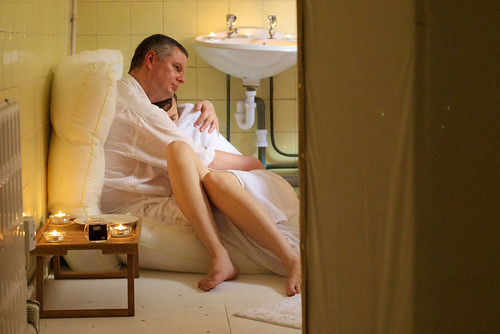Performance is an ‘umbrella’ term that houses many different types of performance and it is important to look into this in respect to our final performance and where we coincide with any of them. Artists that our similar to us are; Oreet Ashiry, Franko B, Adrian Howell and Stelarc (see post entitled ‘Skin’).
A few of these people we have already looked into and questioned some of their conceptual ideas about performance in research to our own, however it is important to highlight that we have developed a show that has links to a collection of other works.
Adrian Howell’s work explicitly attempts to promote intimacy and it could be said that Howell’s work links closest to our piece because of this. Through his works you can see he has himself been through a path of intimacy, using his works as an exploration of the different types of intimacy. He’s washed people’s feet, told him his life stories and heard theirs, he’s held their hands, he’s spooned them in bed, and his piece The Pleasure of Being: Washing, Feeding, Holding is the culmination of all these. This one to one performance invites the audience, to be bathed by Howell to be then wrapped up in a huge towel, after this Howell’s finishes the performance by simply holding the participant. Howell’s tailors this performance to the individual and their needs, whether this be the chance to simply relax and de-stress or to connect to him or even connect to themselves.
Throughout the performance the audience have Howell’s undivided attention, similar to our performance, as when the participant is in our section we give them our full attention. We believe this is a vital component in work surrounding intimacy, because can you really have an intimate moment with someone without giving this sense of devotion?

In the second part of an interview with Howells, we can see a lot of connections with the intentions we had when creating our performance that resonate throughout Howell’s work.
Howell expresses his ideas and beliefs behind his work and he states that he is never a character and that he feels in is important that in his work he is himself, because of the one to one nature. Another point Howell makes that struck out to me was that he states the audience have agency within each of his pieces. And although our piece vastly differs because we are in a sense deconstructing intimacy, I feel these two points tie in with our piece. We are not being characters; we are being ourselves and having genuine and real experiences with the audience. Also as mentioned numerous times, this piece is entirely dependent on the audience, without them are piece could not happen. This is their piece as much as ours.
Oreet Ashery is an artist who mainly works on visual art that is often politically engaging. Ashery often has the audience participate in her works and is known for producing performances as a male character. The main character of Ashery’s as a man that has always held my attention is the portrayal of Marcus Fisher: An Unorthodox Jewish Man. This is Ashery’s most reoccurring character as she is interested in the intersections of Jewishness.
Ashery’s work just goes to show how contrasting some performances may be. Say Cheese, is a performance from Ashery acting as Fisher where there are seven different love stories created in bedrooms in seven different cities. This performance had no specific agenda behind the photographs documented. They were not trying to create an intimate love story, but rather see how the participants reacted. One spectator is said to have continued acting up until the left, telling Fisher that they didn’t love him anymore and were leaving him. However, the seventh performance in Linz left the participant questioning the ‘real’ in respect to the performance and there were some sexual encounters during Say Cheese. This suggests that again a different kind of intimacy has been created between performer and spectator in more than one instance.
This is a different type of work compared to Howell and in comparison to our show, it is evident that we were attempting to create a form of intimacy, along with Howell, not accidentally having that as an outcome of the performance, like Ashery.
In response to this:
Is our performance an original idea?
Have we copied, transformed and combined other peoples work to make our own?
These artists relate in small ways to our performance which indicates that one thing can never be truly original. But that ‘Everything Is A Remix’.


